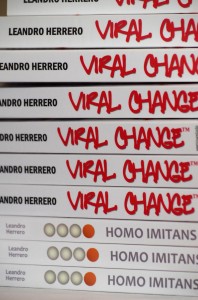 Somewhere in the post-Covid peak, I promised myself that I wasn’t going to pay attention anymore to anything that starts with ‘in these unprecedented times’ (or that the current rate of change is ‘unprecedented’, and variations). Besides being slightly insulting to Mother History, the assertion never leads anywhere, other than perhaps to tranquilizer territory: because it’s so unprecedented, don’t worry, it’s not your fault that you were not prepared. Relax.
Somewhere in the post-Covid peak, I promised myself that I wasn’t going to pay attention anymore to anything that starts with ‘in these unprecedented times’ (or that the current rate of change is ‘unprecedented’, and variations). Besides being slightly insulting to Mother History, the assertion never leads anywhere, other than perhaps to tranquilizer territory: because it’s so unprecedented, don’t worry, it’s not your fault that you were not prepared. Relax.
The Covid pandemic turned our world upside down, yet it is remarkable how fast we have been back to old habits and old platitudes (have a vision, involve stakeholders, be authentic, be yourself) which seem to have been Covid-free.
When you see that the climax of current debate and strategic thinking in organizational terms is the ‘hybrid vs non hybrid’ work issue, happily embraced by academics and gurus who always have an unsolicited view of anything, then we may have to accept that perhaps we have a sad state of affairs in terms of innovation in organizations. The ‘new ways of working’, so much trumpeted by self-declared experts, people who know, seems to come down to office or no office, working from home or not, flexible or not, and a Great Resignation which is permanently announced.
Incidentally, the views of all those organizational gurus are no different from any other mortal, with the difference that they are always preceded by ‘research shows’, even if it would be hard to find any real ‘research’ done by any of them. Other than a SurveyMonkey to a bunch of CEOs, that is.
But, hey, these are unprecedented times, so that may be why we don’t know what to do other than saying that these are unprecedented times.
The old change templates are tired
The traditional organizational change management template (of which the ‘have a vision, involve stakeholders, be authentic, be yourself’ is a representation) is exhausted. It had nothing new to say pre Covid and continues to have nothing new to say now, in these, of course, unprecedented times. It’s still hooked into a mechanistic view of the world that suits ‘project management’ well, but it’s ill-conceived to deal with ‘change management’, particularly cultural change. Conveniently it mixes up both to solve the problem creating an illusion of control that can then be packaged into a book, or two.
For many years I have been struggling with the colossal disconnect between what we, from inside organizations, see as the mechanisms of change and what real change ‘outside the walls’ looks like. That is, in the (macro) socio-political world where our pristine laws of managerial change (7 steps, 5 steps, any steps) survive with the resilience of an ice-cream at the school gates. For example, we are told by some famous ‘change experts’ that we have to create ‘coalitions’ but the managerial world is happy to acquire the language and then… create lots of teams. Because we have no clue what a coalition looks like, but are very good at building teamocracies. Being provocative, I would question the worship of collaboration, a never questioned goal, no matter what. Could you imagine anybody saying ‘we don’t want collaboration?’ Yet, do you really want collaboration between negative and toxic people? Do you think collaboration and excellent team work between terrorists is good?
My professional world is the organizational world. Our clients are corporations, big or small, private or public. However, I now spend 80% of my ‘continuous education time’ on learning and stealing from the macro social change world (e.g social mobilization, political campaigning, social movements) and 20% on tracking Business School like stuff. I stopped my subscription to Harvard Business Review a long time ago with the same mixture of epiphanic revelation as the child that suddenly realises that Santa Claus is not real anymore.
In Shakespeare’s Coriolanus, scene 1, he says that ‘when the sea was calm all boats alike, showed mastership in floating’. It feels like an appropriate description for many ‘change management goals’. Maybe, in these unprecedented times we need to learn how to float again? Just kidding.
White Water Change
What I call White Water Change (when it comes to describing daily life, the rapids of the wild river seem more appropriate than Coriolanus’ calm sea) is an envelope that contains a series of principles that seem to resist being ascribed to either (external) macro social change or (internal) organizational change. To call them universal laws of any-change would be highly pedantic. However, this collection of 40 ‘laws’ seem to be robust enough to be found underneath most situations in which ‘change really works’. They do not belong to a particular Theory of Change but you’d better use them if you want to see that change. Let me share a few examples, just the simple highlights here.
Segmentation. Segmentation means that the world in front is not monolithic and one has to make the effort to tailor your communication. In the socio-political arena you would not survive five minutes if you had one single message for everybody. You don’t talk to a 25 year old worried about employment in the same way or using the same content as you would do when addressing a 60 year old worried about pensions. What is the big deal here? That in corporations we don’t distinguish, and we push down the same ‘communication’ top down to reach all corners, blue collar, white collar, young, old, newcomer, veteran, men, women, part timers, full timers. Regardless. Usually in the same company where the marketing department spends a fortune on (external) market research.
Localization. Localization is another of the 40 principles. ‘Local is not the delivery place’, is the phrase a great client, then friend, used to explain that ‘local’ was actually the place where all stuff happens, as opposed to a place where stuff is delivered into. It took me a little bit to appreciate the wisdom of this apparent triviality. But it was a big aha moment. As in many other projects, we were ‘cooking it’ all centrally to then be ‘delivered’ locally. But what if we got ‘the centre’ wrong? This little disruption of conventional geography (‘de-centring’ is the term used in some social, community development models in the ‘outside the tent’ world) is not trivial. In our business organizations we have adopted some language, for example ‘bottom up’. Wow, that took a while. But language may be deceiving. In some cases its not more than the same top down just migrated a bit downhill. With many corporate ‘bottom up’ you now get the same stuff but at the bottom.
Strength base. A final example has to do with the inevitable question of ‘where to start’. The business organization seems to be obsessed with deficit: what we don’t have, does not work, we are low in. Tons of energy is used in fixing, less in building. Employee engagement surveys tell you what you are lacking, where your scorers are low. OK, also the high ones, but management attention is insignificant compared to the call to arms to investigate the lower-than-benchmark scores. Quite a lot of (macro social) community development in society, starts at the opposite end: banking on strengths, focusing on what we have and how we use it, what we are good at, where the energy is.
I realise that there are 37 more to go! But wanted to share the spirit of these White Water Change principles and highlight once more the underlying belief: there is more to learn from outside the corporate tent than from inside the tent.
We may be in unprecedented times (sorry!) but the issue is that our thinking is highly precedent, almost sea calm like. We’ve got the wrong boats.
____________________________________________________
Learn more about my view on sustainable organizational and behavioural change here [1] and get in contact [2] with my team if you want to learn more.
____________________________________________________

The Myths of Change Webinar with Leandro Herrero and Carlos Escario
Watch on demand [3]: To change to the ‘new normal’ we must think and act differently in the management of our organizations, particularly in the areas of change and transformation.
For a deeper dive into the world of behavioural and cultural change I have written several books – I recommend the following – available on Amazon:

HOMO IMITANS [5] – THE ART OF SOCIAL INFECTION; VIRAL CHANGE™ IN ACTION